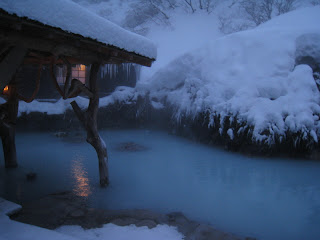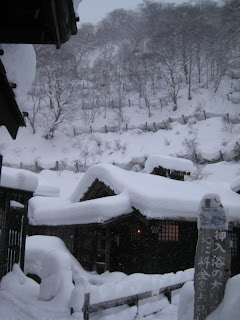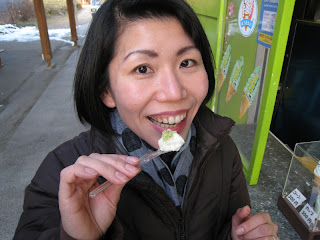While researching the subject using an onsen guide (convenient!), Hiroko was taken with the milky white water of the well-known Tsurunoyu Onsen. The resort's ryokan (inn) had several rooms with a cooking hearth where your meal is cooked over glowing coals. Tsurunoyu is one of the country's most famous onsen and therefore a very difficult reservation to secure. Hiroko actually called the onsen to make our reservation in the Spring of 2010! Since we were going all the way to Akita, we wanted to stay in one of the more rustic rooms to enjoy the whole cooking-in-your-room experience. Fortunately for us, Hiroko was able to reserve one of these rooms.

When we arrived at the ryokan, it was so dark that we couldn't really see much of our surroundings. All we knew was that it was very cold and that we were in a place where there was more snow than we'd ever seen.
The ryokan was old and rustic and known to be originally opened to the public during the Genroku period (1688-1704). The roof of the main building is still made from straw and is replaced every 6 years!
 The main attraction of the resort is milky water onsen. After dinner in the room by the sunken hearth, we headed to a konyoku (coed) outdoor bath. After you take off your clothes, you can wash and clean yourself in an adjacent indoor bath, then go outside to walk the path to the main bath. When we were in onsen, it was snowing and cold. The water was rather lukewarm, and we were getting too cold to be in the water. We were joined by a number of other bathers but it was dark and with the rising steam we couldn't see much of them. The water was very milky and soft, and it was a perfect setting to relax.
The main attraction of the resort is milky water onsen. After dinner in the room by the sunken hearth, we headed to a konyoku (coed) outdoor bath. After you take off your clothes, you can wash and clean yourself in an adjacent indoor bath, then go outside to walk the path to the main bath. When we were in onsen, it was snowing and cold. The water was rather lukewarm, and we were getting too cold to be in the water. We were joined by a number of other bathers but it was dark and with the rising steam we couldn't see much of them. The water was very milky and soft, and it was a perfect setting to relax.Next morning before the breakfast, we decided to soak more in onsen. This time there was no one else there...so quiet...with crisp air, and no snow, it was a relaxing morning bath.
We explored the grounds of the ryokan after the breakfast since we hadn't been able to see much of anything the previous evening when we arrived. The snow created an "authentic snow country vista" that was both beautiful and serene.



















































